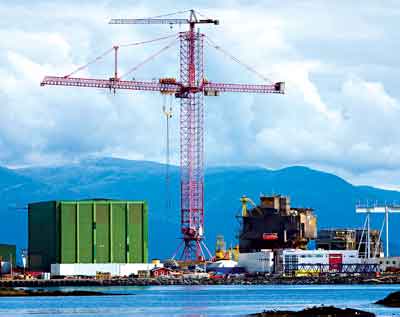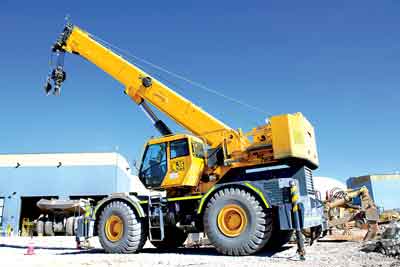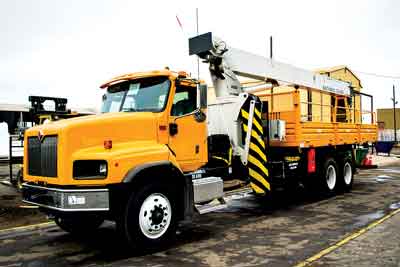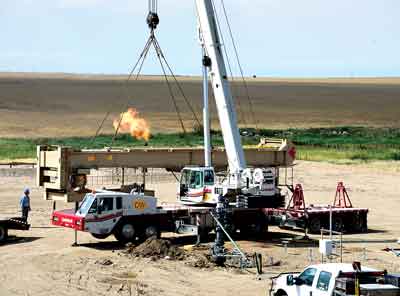
Mining often requires heavy lifting capabilities for both construction and regular maintenance. Selecting the right crane for the job is key.
Mining often requires heavy lifting capabilities for both construction and regular maintenance. Selecting the right crane for the job is key.
By Simon Walker, European Editor
Look at the fleet list for a typical mine, and one will see trucks, excavators, dozers, wheel loaders and other production-orientated equipment. Underground, drill rigs, LHDs and mine trucks predominate. If they appear at all, cranes usually only make a minor appearance, somewhere near the bottom of the list.
The reason, of course, is that craneage is more often than not supplied by the rental market, and unless there are very sound economic reasons for doing so, individual mines rarely need to commit to owning their own cranes. It is usually more effective to hire in lifting capacity as and when it is needed, rather than having the commitment of maintaining machines that require regular safety certification yet may only be used infrequently. The exception here is in the use of small truck cranes, which typically provide fitters and electricians with lifting capacity in their day-to-day maintenance and installation work.
So what types of cranes are most likely to be of use on a mine? Working from the top, so to speak, tower cranes are rarely used outside of major construction projects. They have long-term lifting capacity, but do not have the level of flexibility that most mines need. Nonetheless, there are exceptions, as the example from Syncrude given below illustrates. And it was particularly surprising for the author to see a tower crane installed at the bottom of the Aitik open-pit copper mine on a visit there in the late 1980s—at a time when Boliden was installing a new crushing and conveying system that needed some serious concrete construction.
Similarly, high-lift crawler-mounted cranes have only limited application in day-to-day mining operations, also being more suited for construction. The only real exceptions are where major structures need the lifting capacity these machines can provide, and where perhaps a mobile crane of comparable capacity cannot be obtained. Interestingly, the trend toward mines installing wind turbines to fulfill part of their energy needs may actually increase the need for high-lift crawler-mounted cranes, even though they need specialist transport and erection services.
Hence it becomes clear that for most mine-related work, wheel-mounted mobile cranes provide the answer. Two main classes predominate; multi-axle all-terrain (AT) cranes that can offer lifting capacities from around 30 metric tons (mt) to 1,200 mt, and rough-terrain (RT) cranes that, as the name suggests, are better suited to working in site conditions. Here, capacities range from as little as 25 mt up to around 145 mt, with RTs also able to perform lift-and-carry operations, albeit at the expense of having limited operating range. This makes them more suitable for single-site work—and thus perhaps to mining-company ownership—than to the quick turnaround provided by rental companies that needs the long-distance transport capability provided by ATs.
It is important to remember, of course, that the crane market is very diverse geographically. The main manufacturers target specific models to individual regions of the world, depending on local requirements and operating regulations. In consequence, specifications may vary from region-to-region, or even from country-to-country—a situation that can present major pitfalls for the unwary buyer when investigating the second-hand machine market.
And, in addition to this “gray” area, the sheer size of the crane market means that there is also the significant risk presented by the presence of counterfeit machines and components in some parts of the world. Just this March, for example, Terex issued a warning that not only does it appear that copycat crawler cranes are being made in China and having bogus Terex badges put on them, but that the practice has spread to South Korea. “The units are assembled, branded and sold as used Terex cranes at prices well under market value,” the company explained.
“This is a serious situation, not only because it infringes on our intellectual property but, more importantly, it poses a serious safety risk for our customers,” said Klaus Meissner, director of product strategy for Terex Cranes. “The use of these inferior, counterfeit cranes can result in deadly consequences.”
A RARE SIGHTING
Having said that tower cranes are rarely used on mine sites, this was the option that Syncrude chose when it needed heavy-lift capabilities during the installation of a flue gas desulphurization system at its Mildred Lake refinery. And it was no ordinary tower crane either, with the company having acquired one of only 15 Krøll K 10000 units that were ever built. Free-standing 130 m (427 ft) high, and with a lifting capacity of 100 mt at the end of its 102-m (337 ft)-long jib, the crane performed more than 300 lifts weighing more than 75 mt during the three-year project. Syncrude had looked at crawler cranes for the job, but there wasn’t enough working space for them nor the lifting capacity they needed.
Never previously used (13 of the original units were sold to the Soviet Union for work on nuclear power plants), Syncrude’s K 10000 was restored and fitted with upgraded control systems by Krøll in Denmark before being shipped to northern Alberta in 78 container-loads. Edmonton-based Northern Crane Services Group erected it during the bitter winter of 2007-2008, then won the contract to take it down again—a task that took its team just 43 days in 2011.
The crane itself was mounted on a specially prepared concrete foundation consisting of a 3-m-thick, 15-m-diameter pad supported on a series of 9-m-deep piles. The tower mast was preassembled in sections that were then trucked in to the erection site, with three crawler cranes being used for handling the mast and jib sections. For disassembly, Northern Crane Services again used three crawler cranes, including a 750-mt-capacity Manitowoc 18000 and two smaller Liebherr machines, a 220-mt-lift LR-1200 and a 300-mt-lift LR-1300. A key feature of the operation was that the crane had to be dismantled with the refinery in full operation, with the company noting that it had used a number of innovative techniques to protect workers below as the plant remained live during the entire process.
 Installing one of the wind turbines at Rio Tinto’s Diavik operation. (Photo Rio Tinto).
Installing one of the wind turbines at Rio Tinto’s Diavik operation. (Photo Rio Tinto).INDUSTRY INSIGHTS
Since cranes are not a regular topic for review here, E&MJ sought some insider information. Leigh Sparrow, publisher of the Vertikal.net group’s Cranes & Access, offered these insights into current development trends, and advice on ensuring safe crane operation in the mining environment.
When asked about recent developments in rough terrain cranes, Sparrow noted that RTs are typically larger now, with two axle models of up to 135 mt or more while the average size has increased from 22 mt 25 years ago to 65-75 mt these days. “There has also been a trend to offering RTs with longer booms—often taken from ATs,” he said. “On ATs, crane booms have continued to get longer and there has been a greater emphasis on fuel economy and lower emissions.
“One other major development that is rapidly becoming the norm is safer outrigger setup,” he added. “It is now a requirement on new cranes for outriggers to be set properly before lifting begins, and manufacturers are taking this further with completely automatic systems that allow outriggers to be set up to suit the space available.
“The information on beam extension and jack pressures is fed into the crane’s control system, and a load chart calculated to suit that particular setup. This is a major benefit in terms of safety and efficiency,” Sparrow stated.
Turning to the question whether a mining operation should buy its own cranes or rely on renting in, Sparrow said that key factors are the frequency of a specific type of lift, and the distance between the lift sites. “For example, a mine may well have a series of jobs that can all be sensibly covered with one 65-mt RT. As long as the lifts can be carried out within, say, a five-mile radius and there is a lift at least a couple of times a week, then it’s probably best to buy that particular crane and rent in for rarer larger lifts.”
The “gray market” in cranes is one particular issue facing mines operating in some parts of the world. How can companies reduce this risk? E&MJ asked. “Either find a quality company and sign a contract almost forming a partnership,” Sparrow advised, “or if there is enough work encourage a more distant company to set up a satellite depot at the mine. A final resort is buy-in a crane or two that will handle most of the lifting work.”
Following on from that, there is always the need for companies that are hiring in crane services to satisfy themselves that the cranes being provided are safe and their operators properly trained. “Always be careful in selecting a supplier, and audit their training programs,” he added. “Try to have the same operators—and if in doubt, consider bare rental and having your own key operators.”
 This Krøll K 10000 crane performed more than 300 lifts weighing more than 75 tons as part of a Syncrude refinery upgrade project.
This Krøll K 10000 crane performed more than 300 lifts weighing more than 75 tons as part of a Syncrude refinery upgrade project.CRITICAL SAFETY CONSIDERATIONS
Crane operation is never hit-or-miss; too much is at risk if things go wrong. And being a big operator is no guarantee of safe working. Nearly 10 years ago a hydraulic fluid issue was reportedly the cause of a toppling incident involving a 500 mt AT working at Syncrude, while earlier this year the contractors working on developing Hancock Prospecting’s Roy Hill iron-ore mine in Western Australia suffered the embarrassment of having a crane overturn—while it was being evaluated by a state government inspector.
Overturning remains a major cause of crane accidents worldwide, and is often the result of the ground giving way beneath the outriggers that support a crane while it is lifting. What are the key points that users need to consider in order to minimize this risk? E&MJ asked Sparrow.
“Ground conditions above all else,” he said. “Always err on the side of caution, and always, always use outrigger mats under the jack pads. Do not ‘make do’ with old timber offcuts, but use purpose-built composite, steel, aluminum or wood mats.

“Secondly, keep the load as close to the ground as possible,” he added, “and beware of rearward stability—a fully retracted main boom, with no load when raised to maximum elevation while the full counterweight is installed, is very back-heavy. This is usually OK when the boom is over the front of the crane, and certainly when over the back, but operators forget and slew over the side while they are on the crane’s tires—and over they go. Backward.”
Finally, E&MJ asked him about safe working using RTs for pick-and-carry operations, such as moving conveyor components or lengths of pipeline around a mine.
“A key point here is stabilizing the load,” he said. “The worst thing is a swinging load, as it will impose side stress on the boom and also pull it over. It’s best to travel with the outriggers partially out and close to the ground, so that they act as stabilizers.
“And it’s most important to be fully aware of the terrain. Many a crane has gone over when it has inadvertently moved onto a slight side slope, or the wheels on one side go down into a depression, causing the load to swing outside of the crane’s center of gravity, and then pull it over sideways. Set the outriggers up like stabilizers, and keep the load as close to the ground as possible,” Sparrow advised.
ESSENTIAL OVERHEADS
Somewhat less visible but equally important to any mine with a concentrator, overhead cranes provide day-in, day-out lifting capabilities for all of the mill’s needs: handling reagents and consumables such as mill balls and liners, as well as maneuvering equipment when it needs maintenance or replacement.
And it is not only mills that need this type of crane—plants such as smelters rely on overheads for handling hot metal and slag ladles, while equipment factories are also big users as components are moved from one assembly area to the next.

In June, the Finnish company Konecranes—which is now in the process of merging with Terex Corp.—received an order from Boliden for a 50-ton process crane for use in the converter hall at its Harjavalta copper smelter. According to Juha Lehtonen, Konecranes’ product marketing manager, the new unit has several smart features. These include a target positioning system that brings the load to a predefined position by pushing a single button, and a sway control system that limits any load swing by controlling the bridge and trolley acceleration and deceleration.
The Boliden order came a month after the company had received an order from the steelmaker, SSAB, for two heavy-duty industrial cranes for its Raahe steelworks. One, with a capacity of up to 140 tons, will be used for molten metal handling, while the other will be used for moving slab steel.
Another company in the Terex group, Demag, has reported the supply of seven overhead cranes to the German specialist manufacturer of mixers, Maschinenfrabrik Gustav Eirich. Installed as part of a major modernization scheme at Erich’s factory, the cranes handle products as they are assembled. Mixers are becoming more complex and heavier, so the new cranes have increased the available lifting capacity from 32 mt to 46 mt each—and are set up to work in pairs to increase the capacity further if need be.
As well as these heavy-duty cranes, the plant is now equipped with 12.5-mt-capacity overheads running on a lower level track that are used for component handling and assembly. Demag noted that the compact design of its cranes and hoist units has meant that the height of the assembly line building has been minimized, helping to cut investment and energy costs.

MULTIFACETED MANITOWOC
As well as producing tower and crawler cranes, the Manitowoc group included Grove—which specializes in mobile cranes—and National Crane’s boom trucks. The company told E&MJ about applications for both types of machine in Chile’s mining industry.
The Zaldívar copper mine now has a fleet of eight Grove RT cranes that have been used for tasks such as installing towers, moving containers and carrying electric components, as well as helping during construction of the mine’s mill, maintenance shops and other buildings.
The mine’s first crane, a 50-mt-capacity Grove RT855B, arrived on-site in 1995. “We’re one of very few mines that still have a good condition, 20-year-old Grove crane in use,” said diesel-engine specialist Juan Olivares Cortes. “Each piece of equipment has a very demanding life cycle in a mining environment. “The cranes travel dozens of miles on rough roads, traversing steep grades, and dealing with strong winds, cold, heat and dust,” he explained.
Manitowoc noted that the mine has developed a team of experienced mechanics to tackle its crane fleet maintenance on-site, with each machine that arrives on-site being evaluated in depth to allow the team to calculate its life span and long-term maintenance costs.
Meanwhile, the company reported that its distributor in Chile, Pesco, has designed a series of modifications for its National Crane boom trucks to ensure they meet the strict safety regulations for all vehicles working in the country’s mines. The updates include applying high-visibility yellow paint to the truck’s exterior, building a reinforced flatbed with side gates and a tailgate, and adding clear markings of the crane’s load capacities throughout the unit.
Pesco also installs access handrails, additional lighting, safety signs and decals around the truck’s body, Manitowoc said. Maximum capacities are clearly displayed, along with safety color markings that cover the hook block and the boom truck’s outrigger jacks.
Advantages of using boom trucks include their quick setup and teardown times, which allows workers to move quickly from site to site, while additional permitting is not usually required for highway travel, saving time and money, the company added.

IMT’S TRUCK-MOUNTED CRANES
According to the product manager of material handling at Iowa Mold Tooling Co. (IMT), John Field, the company has developed all of its truck-mounted cranes, which include telescopic and articulating models, for use in rugged terrain. “We’ve recently seen significant growth in articulating crane sales in the mining market,” he told E&MJ. “A few years ago, we saw more telescopic cranes in the mines, but now articulating cranes are better meeting the lifting needs of these customers, and are therefore becoming more common.
“Mining equipment is so large that customers are finding they need articulating cranes to better handle the weight of these components without overhead obstructions, as is the case with typical center-mount telescopic cranes,” Field added. “IMT has a wide variety of articulating material-handling cranes that have farther reach and greater lifting capacities required to handle large components. We have about 30 crane models with maximum horizontal reaches of up to 33.6 m and crane ratings of up to 72-ton-m.
As far as industry applications go, Field noted that IMT has sold several cranes to the Escondida mine in Chile, where they are used for maintenance, working on haul trucks, and other tasks.
As well as truck-mounted cranes, IMT offers a six-model range of mechanics’ trucks, equipped with an integral crane hoist. In September, the company launched a new body design for its Dominator III vehicle, fitted with an IMT model 12000 telescopic crane that provides up to 9.1 m (30 ft) of reach. The new body will be available in both 3.4- and 4.3-m lengths, with the Dominator III designed for midrange lifting needs.
LIEBHERR LIFTS HIGH AT ANTAMINA
In its June 2013 edition (pp. 86–87), E&MJ reported on the use of three Liebherr AT cranes to lift a 140-mt bucket wheel during a major overhaul on one of the excavators at RWE Power’s Hambach lignite mine in Germany. Liebherr has since provided information about one of its crawler cranes, which has been on long-term hire to Joy Global for use at the Antamina copper-zinc mine in Peru.

The first of this type in Latin America, the LTR 1220 telescopic crawler crane has a maximum load capacity of 220 mt, and was used for unloading the components of two mining shovels, and then assembling them. Liebherr claims that its hydraulic telescopic boom and crawler gear allowed the crane to handle the most difficult terrain, making it well-suited for this type of work. Benefits include its high load capacity, short setup times, good maneuverability and its ability to travel with a full load.
With the mine at an altitude of near 5,000 m, conditions are tough, with extreme temperature fluctuations. Nonetheless, Liebherr reported that the crane’s owner, Gruas Alquileres, has confirmed that the crane has worked efficiently and safely, handling the conditions well.
Meanwhile, Liebherr’s LTM range of mobile cranes runs to no fewer than 21 models, designed for both on- and off-road applications. Capacities range from 35 mt and a maximum lifting height of 44 m for the two-axle LTM 1030-2.1 to 1,200 mt and a top height of 188 m for the nine-axle LTM 11200-9.1. Compact by design, their advantages include their versatility and mobility, with travel speeds of up to 80 km/h (50 mph), the company stated.
TEREX’S AUSSIE PICK-AND-CARRIES
Terex’s Australian operations have developed pick-and-carry cranes, which, the company told E&MJ, offer strength and easy operation to pick up heavy loads while having steering flexibility to move in tight spaces. Their high road speed gets them to the jobsite quickly, and because the articulated frame needs no outriggers, they can be set up and working almost immediately, Terex claims.

Features of Terex pick-and-carry cranes include a spacious operator’s cab, a binnacle-type dashboard, pilot-operated hydraulics and a digital load indicator. Both the hydraulic oil and fuel tanks have been integrated around the six-cylinder turbocharged and intercooled engine in the rear body, with the latest design in adjustable wear pads and boom structure up front.
The center-articulated AT-15-3 model has a lifting capacity of 15 mt and a maximum boom length of 17.9 mthe four-section boom having two powered sections, the third being manual. Forty-degree articulation each side of center provides an 80° slewing arc. The larger AT-22 has a 22-mt lifting capacity at 1.4 m radius, reducing to 1.7 mt at the maximum 15.8-m radius, while offering a top hook height of 17 m.
With capacities from 35 mt to 118 mt, Terex’s 16-model lineup of RT cranes offer three steering modes, a compact and rugged design, the ability to telescope the boom under load for precise load positioning, and a comfortable, ergonomic cab with intuitive controls. Their six-speed powershift transmission and four-wheel drive allow them to access worksites even in difficult terrain. Construction is from high-strength steel, tested to withstand extreme temperatures, while their axles and superstructures are designed to withstand mud, snow and similar challenging conditions, the company says.

LINK-BELT’S LONG-DISTANCE RUNNER
Aside from providing adequate lifting capacity, crane mobility can be a major factor when a mining company operates from several locations. U.S. crane manufacturer Link-Belt recently reported that one of its HTC-8675 Series II 70 mt hydraulic truck cranes had accumulated more than 17,500 km (11,000 miles) running between worksites in just 10 months. Servicing the North Dakota oil and gas industry, the crane is often called on to lift and precision place 27-mt pump units, as well as lighter production components.
Highlighting the versatility of this type of crane, the machine’s owners (Dacotah West Crane Service) explained that its 100 km/h (65 mph) travel speed meant that it can move quickly from site to site. In addition, the state imposes strict load restrictions on roads during the Spring thaw season, meaning that ATs have limited use, while the Link-Belt crane’s axle loading of just 5.4 mt means that it can still travel.
The company noted that the HTC-8675 is easy to permit, even with all of 46 mt of counterweight on board. The triple-axle boom dolly carries all the counterweights for road travel, with fast rigging and breakdown making the crane operator-friendly in use.
ZOOMLION MOVES INTO MINING
One of China’s largest construction-equipment manufacturers, Zoomlion, produces a complete range of cranes, from RTs up to towers. In 2013, its international sales agent, Global Cranes & Machinery, reported that it had sold a Zoomlion RT55 55 mt-capacity RT to Southern Peru Copper Corp. This is one of five models in the company’s RT range, which offer capacities from 35 to 100 mt.
In June, Zoomlion itself reported the sale of 13 cranes to a major but unnamed copper-development project in Kazakhstan. The sale included two QUY260 crawler cranes, plus one QY100, two QY80s, four QY55s and four QY25 truck cranes. The company stated that this is the first time that a Chinese crane manufacturer has exported so many cranes to the Central Asian market, while the sale of the QUY260s marked the first foray for this crawler into this region. The crane has a maximum capacity of 260 mt at a 5-m radius on a 20-m-long boom, but can carry up to 122 m of combined main boom and luffing jib.









